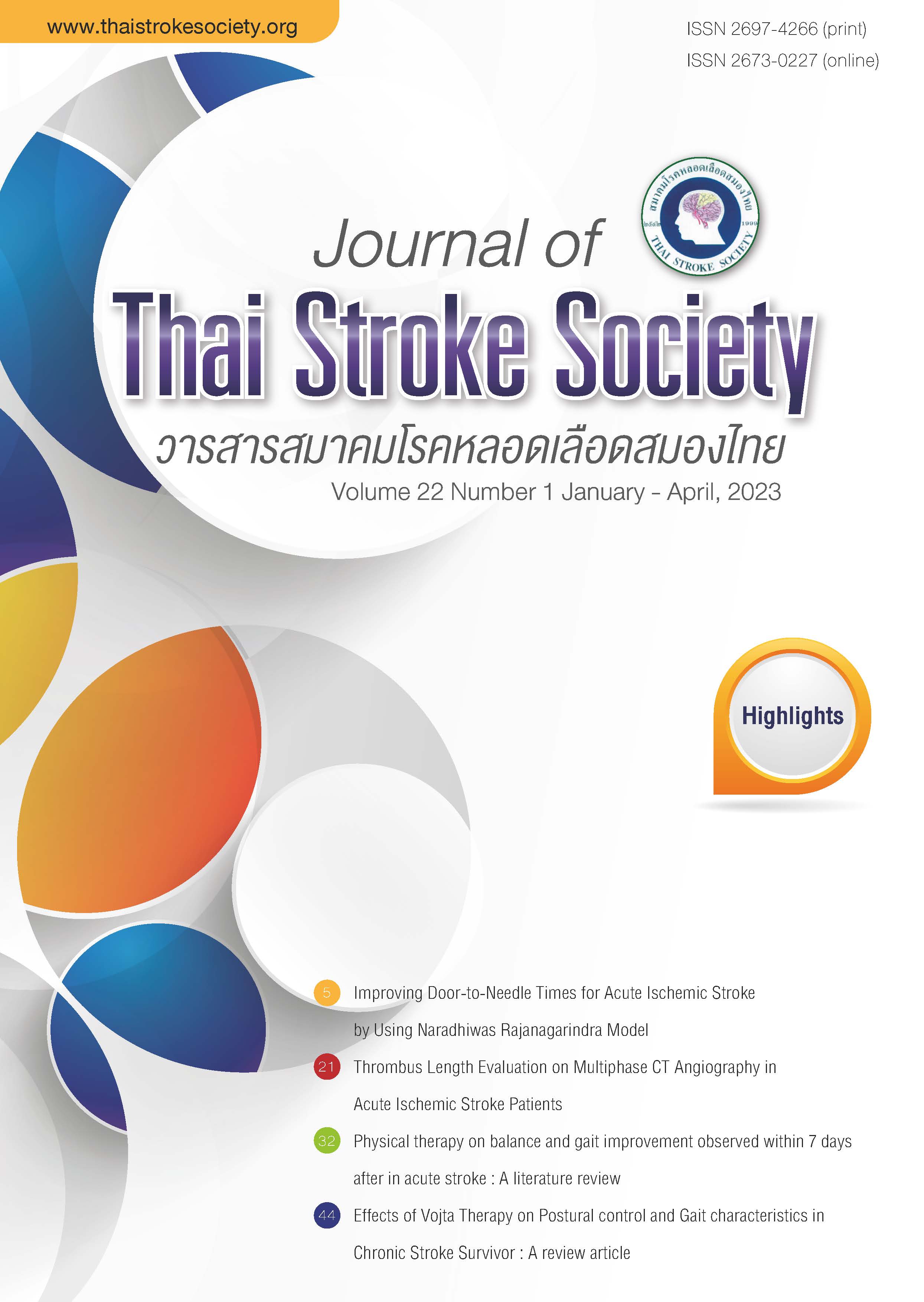Improving Door-to-Needle Times for Acute Ischemic Stroke by Using Naradhiwas Rajanagarindra Model
Keywords:
acute ischemic stroke, door-to-needle time, stroke fast trackAbstract
Background: The implement of stroke fast track strategies is associated with reduction in treatment times for tissue-type plasminogen activator (t-PA) administration. The impact strategies are variety in each area as well as Naradhiwas Rajanagarindra Hospital.
Objectives: The study aims to report the outcome after developing Naradhiwas Rajanagarindra model.
Methods: In this prospective cohort study, we collected data from the study survey in 160 stroke fast track patients from Naradhiwas Rajanagarindra Hospital between August 1, 2021 to January 31, 2022. Divided in 3 groups, phase I was analyzed baseline performance. In phase II, strategies changes were implemented. Using the model then collected outcome in phase III. Data analysis of difference between groups were performed using Kruskal-Wallis H. and Mann-Whitney Test.
Results: Number of patients are 45 in phase I, 29 in phase II, and 86 in phase III. 13.84 % decrease in door-to-refer time (P-value=0.429). 26.28 % decrease in door-to-door time (P-value=0.027). 34.41 % decrease in door-to-CT time (P-value=0.027). Mean door-to-needle time in phase III is 27.79 minutes and the study can improve door-to-needle time 28.58 % (P-value<0.001).
Conclusion: Development of Naradhiwas Rajanagarindra Hospital stroke fast track model is associated with reduction in referral time, and administering time of t-PA.
References
Jauch EC, Saver JL, Adams HP, Jr., Bruno A, Connors JJ, Demaerschalk BM, et al. Guidelines for the early management of patients with acute ischemic stroke: a guideline for healthcare professionals from the American Heart Association/American Stroke Association. Stroke. 2013;44(3):870-947.
Kwiatkowski TG, Libman RB, Frankel M, Tilley BC, Morgenstern LB, Lu M, et al. Effects of tissue plasminogen activator for acute ischemic stroke at one year. National Institute of Neurological Disorders and Stroke Recombinant Tissue Plasminogen Activator Stroke Study Group. N Engl J Med. 1999;340(23):1781-7.
Hacke W, Kaste M, Bluhmki E, Brozman M, Davalos A, Guidetti D, et al. Thrombolysis with alteplase 3 to 4.5 hours after acute ischemic stroke. N Engl J Med. 2008;359(13):1317-29.
Lansberg MG, Schrooten M, Bluhmki E, Thijs VN, Saver JL. Treatment time-specific number needed to treat estimates for tissue plasminogen activator therapy in acute stroke based on shifts over the entire range of the modified Rankin Scale. Stroke. 2009;40(6):2079-84.
Saver JL. Time is brain--quantified. Stroke. 2006;37(1):263-6.
Saver JL, Fonarow GC, Smith EE, Reeves MJ, Grau-Sepulveda MV, Pan W, et al. Time to treatment with intravenous tissue plasminogen activator and outcome from acute ischemic stroke. JAMA. 2013;309(23):2480-8.
Marler JR, Tilley BC, Lu M, Brott TG, Lyden PC, Grotta JC, et al. Early stroke treatment associated with better outcome: the NINDS rt-PA stroke study. Neurology. 2000;55(11):1649-55.
Lees KR, Bluhmki E, von Kummer R, Brott TG, Toni D, Grotta JC, et al. Time to treatment with intravenous alteplase and outcome in stroke: an updated pooled analysis of ECASS, ATLANTIS, NINDS, and EPITHET trials. Lancet. 2010;375(9727):1695-703.
Powers WJ, Rabinstein AA, Ackerson T, Adeoye OM, Bambakidis NC, Becker K, et al. Guidelines for the Early Management of Patients With Acute Ischemic Stroke: 2019 Update to the 2018 Guidelines for the Early Management of Acute Ischemic Stroke: A Guideline for Healthcare Professionals From the American Heart Association/American Stroke Association. Stroke. 2019;50(12):e344-e418.
Fonarow GC, Smith EE, Saver JL, Reeves MJ, Hernandez AF, Peterson ED, et al. Improving door-to-needle times in acute ischemic stroke: the design and rationale for the American Heart Association/American Stroke Association's Target: Stroke initiative. Stroke. 2011;42(10):2983-9.
Xian Y, Xu H, Lytle B, Blevins J, Peterson ED, Hernandez AF, et al. Use of Strategies to Improve Door-to-Needle Times With Tissue-Type Plasminogen Activator in Acute Ischemic Stroke in Clinical Practice: Findings from Target: Stroke. Circ Cardiovasc Qual Outcomes. 2017;10(1).
สถาบันประสาทวิทยา กรมการแพทย์. แนวทางการรักษาโรคหลอดเลือดสมองตีบหรืออุดตันสำหรับแพทย์. 2562.
Kamal N, Holodinsky JK, Stephenson C, Kashayp D, Demchuk AM, Hill MD, et al. Improving Door-to-Needle Times for Acute Ischemic Stroke: Effect of Rapid Patient Registration, Moving Directly to Computed Tomography, and Giving Alteplase at the Computed Tomography Scanner. Circ Cardiovasc Qual Outcomes. 2017;10(1).
Kunadison S. Ineligibility of Intravenous Thrombolysis among Activated Stroke Fast Track Patients of Khon Kaen Hospital. Journal of Thai Stroke Society. 2019;18(2).
Viratyaporn W. ประชุมเครือข่ายบริการสุขภาพเขต12. 2020.
Worathitianan บ. Improved Stroke Fast Track Strategy leads to 6 Minutes Door-To-Needle Time. Journal of Thai Stroke Society. 2020;19(1):5.
Downloads
Published
How to Cite
Issue
Section
License
Copyright (c) 2023 Journal of Thai Stroke Society

This work is licensed under a Creative Commons Attribution-NonCommercial-NoDerivatives 4.0 International License.
ข้อความภายในบทความที่ตีพิมพ์ในวารสารสมาคมโรคหลอดเลือดสมองไทยเล่มนี้ ตลอดจนความรับผิดชอบด้านเนื้อหาและการตรวจร่างบทความเป็นของผู้นิพนธ์ ไม่เกี่ยวข้องกับกองบรรณาธิการแต่อย่างใด การนำเนื้อหา ข้อความหรือข้อคิดเห็นของบทความไปเผยแพร่ ต้องได้รับอนุญาตจากกองบรรณาธิการอย่างเป็นลายลักษณ์อักษร ผลงานที่ได้รับการตีพิมพ์ในวารสารเล่มนี้ถือเป็นลิขสิทธิ์ของวารสาร





